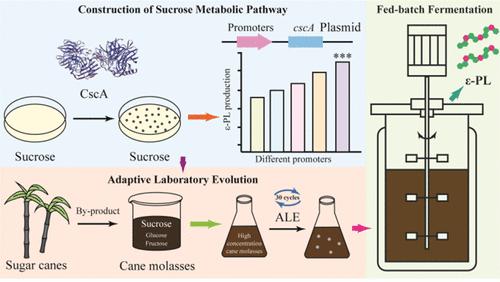当前位置:
X-MOL 学术
›
J. Agric. Food Chem.
›
论文详情
Our official English website, www.x-mol.net, welcomes your
feedback! (Note: you will need to create a separate account there.)
Enhancing the Production of ε-Poly-l-Lysine by Engineering the Sucrose Metabolism Pathway in Streptomyces albulus PD-1 Using Cane Molasses
Journal of Agricultural and Food Chemistry ( IF 5.7 ) Pub Date : 2024-11-18 , DOI: 10.1021/acs.jafc.4c07204 Zhaoqiong Liu, Min Chen, Shanshan Du, Rui Wang, Yibin Qiu, Sha Li, Hong Xu, Delei Xu
Journal of Agricultural and Food Chemistry ( IF 5.7 ) Pub Date : 2024-11-18 , DOI: 10.1021/acs.jafc.4c07204 Zhaoqiong Liu, Min Chen, Shanshan Du, Rui Wang, Yibin Qiu, Sha Li, Hong Xu, Delei Xu

|
Cane molasses, a sugar-rich agro-industrial byproduct, was used to enhance the production of ε-poly-l-lysine (ε-PL) in Streptomyces albulus PD-1 as a cost-effective carbon source. The sucrose metabolism pathway was engineered by heterologously expressing sucrose-6-phosphate hydrolase from Escherichia coli W. The optimization of various promoters identified the SP44 promoter, increasing the total sugar utilization rate by 2.76-fold compared with the ermEp* promoter. Additionally, adaptive laboratory evolution improved the total sugar utilization rate. The evolved strain achieved an ε-PL titer of 2.65 ± 0.15 g/L in flask experiments, increasing the ε-PL titer by 7.16-fold compared with the unevolved strain. Comparative transcriptomic analyses revealed that the enhanced tolerance of the evolved strain to high concentrations of cane molasses was primarily due to modifications in the sucrose metabolism pathways, microbial metabolism in heavy metals and phenols, and the amino acids transport and metabolic pathways. These changes enabled more efficient ε-PL production. During fed-batch fermentation in a 5-L fermentor using a concentration of 50 g/L cane molasses, the ε-PL titer reached 36.88 ± 0.62 g/L, and dry cell weight was 41.1 ± 1.0 g/L. This study illustrates that cane molasses is an economical carbon source for producing ε-PL on an industrial scale.
中文翻译:

通过使用甘蔗糖蜜设计白链霉菌 PD-1 中的蔗糖代谢途径来增强 ε-聚-l-赖氨酸的产生
甘蔗糖蜜是一种富含糖分的农业工业副产品,用于提高白链霉菌 PD-1 中 ε-聚-l-赖氨酸 (ε-PL) 的生产,作为一种具有成本效益的碳源。蔗糖代谢途径是通过异源表达来自大肠杆菌 W 的蔗糖-6-磷酸水解酶来设计的。各种启动子的优化确定了 SP44 启动子,与 ermEp* 启动子相比,总糖利用率提高了 2.76 倍。此外,适应性实验室进化提高了糖的总利用率。在培养瓶实验中,进化的菌株实现了 2.65 ± 0.15 g/L 的 ε-PL 滴度,与未进化的菌株相比,ε-PL 滴度提高了 7.16 倍。比较转录组学分析显示,进化菌株对高浓度甘蔗糖蜜的耐受性增强主要是由于蔗糖代谢途径、重金属和酚类微生物代谢以及氨基酸转运和代谢途径的改变。这些变化使 ε-PL 生产更加高效。在 5 L 发酵罐中使用浓度为 50 g/L 的甘蔗糖蜜进行分批补料发酵时,ε-PL 滴度达到 36.88 ± 0.62 g/L,干细胞重为 41.1 ± 1.0 g/L。本研究表明,甘蔗糖蜜是工业规模生产 ε-PL 的经济碳源。
更新日期:2024-11-18
中文翻译:

通过使用甘蔗糖蜜设计白链霉菌 PD-1 中的蔗糖代谢途径来增强 ε-聚-l-赖氨酸的产生
甘蔗糖蜜是一种富含糖分的农业工业副产品,用于提高白链霉菌 PD-1 中 ε-聚-l-赖氨酸 (ε-PL) 的生产,作为一种具有成本效益的碳源。蔗糖代谢途径是通过异源表达来自大肠杆菌 W 的蔗糖-6-磷酸水解酶来设计的。各种启动子的优化确定了 SP44 启动子,与 ermEp* 启动子相比,总糖利用率提高了 2.76 倍。此外,适应性实验室进化提高了糖的总利用率。在培养瓶实验中,进化的菌株实现了 2.65 ± 0.15 g/L 的 ε-PL 滴度,与未进化的菌株相比,ε-PL 滴度提高了 7.16 倍。比较转录组学分析显示,进化菌株对高浓度甘蔗糖蜜的耐受性增强主要是由于蔗糖代谢途径、重金属和酚类微生物代谢以及氨基酸转运和代谢途径的改变。这些变化使 ε-PL 生产更加高效。在 5 L 发酵罐中使用浓度为 50 g/L 的甘蔗糖蜜进行分批补料发酵时,ε-PL 滴度达到 36.88 ± 0.62 g/L,干细胞重为 41.1 ± 1.0 g/L。本研究表明,甘蔗糖蜜是工业规模生产 ε-PL 的经济碳源。































 京公网安备 11010802027423号
京公网安备 11010802027423号